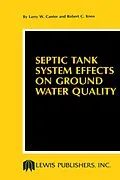This valuable reference delineates the ground water quality concerns associated with the planning and usage of septic tank systems. Septic tank systems represent a significant source of ground water pollution in the United States. Since many existing systems are exceeding their design life by several-fold, the usage of synthetic organic chemicals in the household and for system cleaning is increasing, and larger-scale systems are being designed and used.
Autorentext
Larry W. Canter, Robert C. Knox
Inhalt
1-INTRODUCTION. Septic Tank System Regulation. 2-DESIGN OF SEPTIC TANK SYSTEMS. Overview. 3-GROUND WATER POLLUTION FROM SEPTIC TANK SYSTEMS. Potential Pollutants from System Effluents. Mechanisms of Ground Water Contamination from Septic Tank Systems. Transport and Fate Contaminants. Ground Water Pollution Control Measures. Monitoring. Septage. 4-METHODOLOGIES AND MODELING. Concept. Previous Usage of Technical Methodologies. Selection Criteria for Technical Methodologies. Empirical Assessment Methodologies. Hantush Analytical Model. Konikow-Bredehoeft Numerical Model. Hierarchical Structure for Model Usage. 5-SUMMARY. Septic Tank Systems. Effluent Quality. Ground Water Pollution from Septic Systems. Evaluation of the Ground Water Pollution Potential of Septic Tank Systems. APPENDIX: Phillips, Nathwani and MOOIJ Assessment Matrices. Error Function in Hantush Analytical Model. Fortran IV Program for Konikow-Bredehoeft Solute-Transport Model. 336 pp.,
